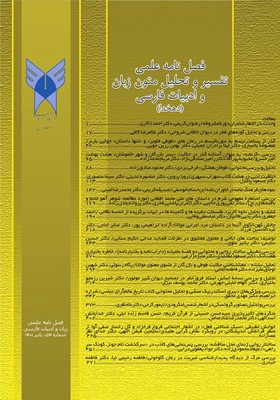ساختار روایی ژنهای محل مناقشه: بررسی پسنماییهای کاذب در «سرگذشت تام جونز، کودک سر راهی»
محورهای موضوعی : متون زبان و ادبیات فارسیمیعاد محمودی زاده 1 , جواد یعقوبی درابی 2 * , نعیمه طباطبایی لطفی 3
1 - دانشجوی دکتری گروه زبان و ادبیات انگلیسی، واحد تهران جنوب، دانشگاه آزاد اسلامی، تهران، ایران.
2 - استادیار گروه زبان و ادبیات انگلیسی، واحد کرج، دانشگاه آزاد اسلامی، کرج، ایران.
3 - استادیار گروه مترجمی زبان انگلیسی، واحد شهرقدس، دانشگاه آزاد اسلامی، تهران، ایران.
کلید واژه: سرگذشت تام جونز, پسنمایی کاذب, روایتشناسی, ژرار ژنت, زمانپریشی, پسنمایی, دوران عطوفت,
چکیده مقاله :
ساختار روایی ژرار ژنت یکی از الگوهای روایتشناسی است که بیشترین توجه را در میان تمامی الگوهای دیگر به خود جلب کرده است. استفاده از الگوی ژنهای برای تحلیل آثار ادبی امکان بررسی بسیار دقیق اثر را برای پرژوهشگران فراهم میسازد. این دقت در بررسی آثار بهقدری است که گویی نویسندگان این آثار ادبی در زمان نگارش آثار خویش ساختاری همانند ساختار روایی ژنت در دست داشتهاند و آثار خود را مطابق قاعدههای موجود در این الگوی روایی تنظیم نمودهاند – که این خود مهر تایید بر جامع بودن تئوری ژنت است. در این مقاله، روایتشناسی ژرار ژنت از زاویه دید نسبتأ متفاوتی و در یکی از آثار برجسته دوران عطوفت در ادبیات بریتانیا به نام سرگذشت تام جونز، کودک سر راهی مورد بحث قرار گرفته است. چیرگی قواعد روایتشناختی ژنهای در این اثر امری است غیر قابل انکار که در این مقاله از طریق خوانشی صورتگرایانه به آن پرداخته شده است. همچنین، در پژوهش حاضر، استفاده از پسنمایی ژنهای برای اولین بار در این برهۀ تاریخی به عنوان نوعی از زمانپریشی و تبدیل آن به پسنمایی کاذب توسط هنری فیلدینگ مورد بررسی قرار گرفته است. علاوه بر آن، این مهم که تأثیر زمانپریشی در چنین اثری نمیتواند انکار گردد نیز به اثبات رسیده است. اثر فیلدینگ نهتنها از تکنیک زمانپریشی استفاده میکند، بلکه شاخۀ جدیدی از آن را نیز معرفی مینماید که همان زمانپریشی از نوع پسنمایی کاذب است.
In the world of narratology today, Gérard Genette’s narrative typology is among the most annotated schemata and it is widely popular since his narrative theory seems to prevail over a great number of narratives in the whole history of literature, ranging from classic to modernist and postmodernist works. It is as if such works were following a prescribed scheme to expand and develop – which proves the universality of his narrative theory. Throughout this article, Genettian typology is discussed from a partially different perspective in one of the canonical British prose works in The Age of Sensibility. The dominance of Genettian typology in Tom Jones is undeniable as it shall be discussed how; however, a modification and manipulation of one of the anachronies – analepsis – and the introduction of a new type of analepsis – false analepsis – by Henry Fielding employed for the first time in the very period is the major focus of this article. In this study, false analepsis are justified by means of exemplification and multiple references to Tom Jones as the only case study of this article. Moreover, the impact of anachronies on this work is emphasized. Fielding’s work not only employs anachronies, but also introduces a new branch of anachronies, which is the very false analepsis as a form of anachrony.

